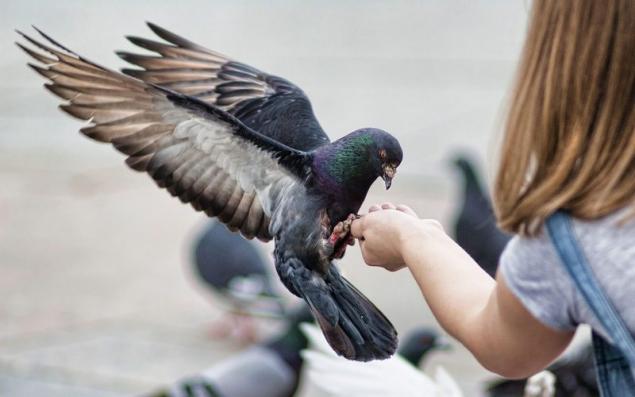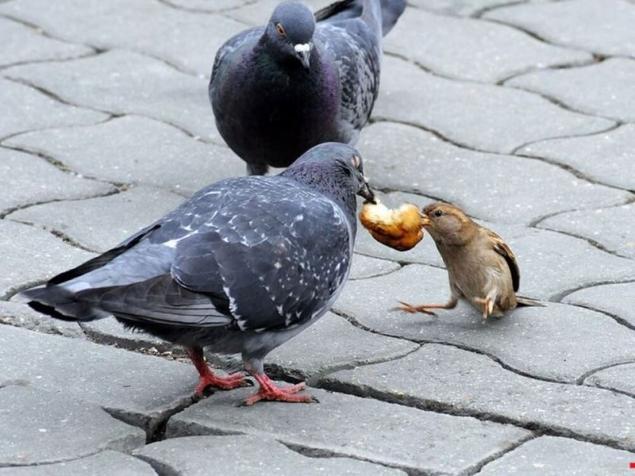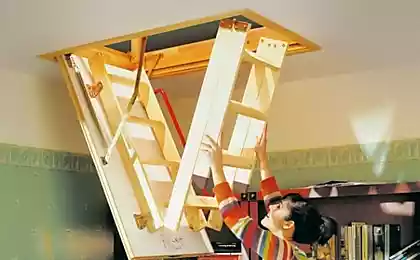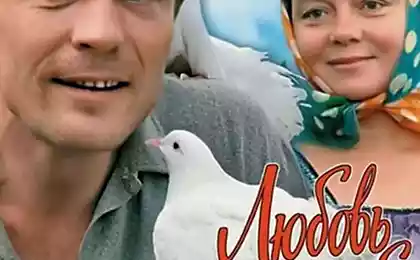736
Birds of the world, but not of health: something about flying rats
People perceive pigeons in different ways: some (a symbol of peace, of love, without the support of a person they will die); others are against ("flying rats", importunate, unscrupulous hawkers of infection). Today once again watched as the children squeeze the pigeons and crawling in their litter, joyful and dangerously careless. So I decided to warn you that pigeons can represent a serious threat to your health as they are carriers of many infectious diseases. Worse than that, that pigeon feces are a source of infection and inhalation no less dangerous than direct contact with pigeons.

A single pigeon is 12 kg of faeces per year! This, seemingly so harmless, the bird can be a vector 90 agents of many diseases, including the ten zoonotic infections (zoonoses), that is, those that are transmitted to humans from animals. Living in cities pigeons can carry a variety of insect parasites that live not only on birds but also in their Gnezdovo. In addition, just like rodents, pigeons dig in the trash and carry various insects – bedbugs, fleas, various beetles and mites. They live on the pigeons and their nests.
Diseases transmitted from animals to humans are called zoonoses. Pathogens of these diseases can be protozoa, fungi, bacteria, chlamydia and viruses. Individual susceptibility to them, each person depends on the state of the immune system, age, health condition and other factors. Psittacosis Psittacosis (also known as psittacosis or parrot disease) is a bacterial infection that is most common in parrots and their relatives, however, sometimes it appears and other birds, including pigeons. People can be infected with psittacosis, if you accidentally inhale particles of dried droppings of a sick bird. 10 days after infection in a human patient there is weakness, fever, headache, rash, chills, and pneumonia. Chlamydia psittaci was found in 52.6 percent of the pigeons captured. Infection from this bacteria leads to symptoms like a mild flu-like illness and severe pneumonia. Most of these diseases are recorded in spring and autumn, this is due to lowered immunity in young birds and their susceptibility to diseases. The largest epidemiological importance of poultry (ducks, turkeys), house birds (parrots, budgerigars, Canaries and other small songbirds), and especially city pigeons, infestation ranging from 30% to 80%. The causative agent of psittacosis, unlike other chlamydia, capable of long-term preservation in the environment: maintains viability at 37 °C to 2 days at 4-6 °C and during the week; after lyophilization the causative agent is stored for 5 years or more. The incubation period for psittacosis ranges from 5 to 30 days (usually 10-12 days). In the beginning disease is characterized by fever with chills and excessive sweating, sore throat, muscles and joints. Note conjunctivitis, thickened tongue with possible teeth marks on the edges, often hepatolienal syndrome, emotional disturbances (agitation, irritability, tearfulness). With 3-4 days of illness develop laryngitis or bronchitis, or interstitial pneumonia is dotted with sparse physical data. With a special survey on psittacosis in different countries (Bulgaria, Holland, USA, Germany, etc.) found that 10-20% of acute pneumonia has ornidazol etiology. In Moscow psittacosis was diagnosed in 18.4% of patients with acute pneumonia, in Saint-Petersburg — 19,6%. Doctors say that though seasonal outbreaks of diseases psittacosis and there is, after all, get sick more often in cold season. This is caused by several reasons, one of which is the similarity of the symptoms of psittacosis the symptoms of SARS and common colds, which complicates the diagnosis. Besides, in the cold, the pigeons gather in large flocks and, consequently, the infection spreads quickly. One sick bird can infect an entire flock. And then the friggin flock scatters of the city's garbage containers, which are often installed near locations where children walk.

Thus, in the city there are many places where you can catch psittacosis and other diseases. Ornithologist Natalia Obukhova says in this regard that the debris and dirt in the cities contributes to the rapid increase in the number of pigeons. The population of birds in Moscow no one was watching, but the incidence among Muscovites psittacosis to order more than the same with rabies. To psittacosis is more stable, but the disease is severe (severe headaches, fever, weakness of the whole body). It is very similar to the flu and acute respiratory diseases. Children pick up the infection more often than adults, as you can touch the birds, playing with them. The children need to watch and explain to them what might be the trouble for communicating with birds. Salmonellosis salmonellosis is an intestinal disease caused by numerous pathogens of the genus Salmonella. The main sources of infection are animals, and occasionally people. Asymptomatic disease is established in many species of farm animals, cats, dogs, rodents, birds. "The disease risk to humans is not subject to standard measures of personal hygiene and the exclusion of direct contact with a sick bird. Activators of avian influenza and psittacosis (an infection that can be transmitted to humans) is not revealed", — said in the Committee. The usual clinical symptoms in all animals include diarrhoea, vomiting, fever. The infection can progress in the direction of dehydration, weakness, and sometimes, especially in the case of very young or very old individuals, to death. In severe cases, it can be a high fever, septicemia (blood poisoning), headaches and enlarged, painful spleen. Focal infection can occur in various organs, including the heart, kidneys, ligaments, soft shell, surrounding the brain and spinal cord and the connective tissue surrounding all bones of the body. The incubation period is 12-36 hours. Salmonella is transmitted by eating food contaminated with droppings. The selection of bacteria ill person can last from several days to several weeks. Campylobacter jejuni Till 1972 when it developed a reliable method for isolating Campylobacter jejuni was considered pathogenic only for animals (sheep and cattle). However, further studies revealed their danger to humans. According to the FDA (U. S. Food & Drug Administration) — Management Food and Drug administration, at present, Campylobacter jejuni is the most common cause in humans of a bacterial diarrhoea. Moreover, C. jejuni causes more cases of disease than Shigella spp. and Salmonella spp. together. They are present in most representatives of this bird population and can be more harmful than a well-known Salmonella. Street pigeons serve as reservoirs for some of the production and growth of species of bacteria, therefore, they can lead to harmful diseases. Campylobacter jejuni, which was present in 69.1% caught pigeons causes abdominal pain, diarrhea, fever, and malaise of a General nature in infected individuals. Thermophilic Campylobacter species are considered major pathogens of acute diarrheal diseases in different countries of the world — and more often than Salmonella." Infection Newcastle Newcastle Infection a sick dove can infect and humans through the mucous membranes of the eye. However, for a person it is not as dangerous as the birds, occurs in the form of colds, conjunctivitis with swelling of the parotid lymph nodes during one week. Exposed can be mainly workers in bird farms, and laboratory staff. Paramyxovirus so, doves are a natural carrier of paramyxoviruses, which can spread to domestic poultry, including chickens, turkeys, geese, ducks, pheasants, Guinea fowl and even ostrich, EMU and Rhea. The virus is resistant, stands with pigeon droppings, which can exist in about 3-4 weeks. This means that your soles, and even clothing can be a vehicle for viruses. Because the paramyxovirus, though not deadly to humans, yet can cause people a very unpleasant disease. As noted by the Deputy head of the Rosselkhoznadzor Alexei Alekseenko, this infection can enter the human body through the mucous membrane of the eye, causing symptoms resembling the common cold and conjunctivitis with swelling of the parotid lymph nodes during one week. It seems nothing special, but pleasant enough. Surface acariasis in Addition to the scabies skin lesions in humans can cause ticks that live on animals and birds (dogs, cats, rats, pigeons), on cereals, grass and straw, feather pillows, etc. occurs most Often lose people cessationism mite of horses, rat, chicken and pigeon mites. The last three species can cause mass destruction in families, hostels. Unlike scabies, caused by Scabiei hominis, these types of mites do not burrow into the Horny layer and do not form moves, and only applied to the bites, causing intense itching and the formation in their place of papules or blisters, which are often visible dot haemorrhage or a more intense color, serous or hemorrhagic crusts, vesicles (bite mark). Elements of the rash found most often in areas of close contact of the skin with clothes. Ticks are found in underwear and bed linen, on the premises. Some of gamasoidea mites, parasitic on birds and rodents, live in their nests. With the disappearance of the natural host, they attack the person. Flash dermatoses observed, in particular, after cleaning the debris from the infield or after the departure of the pigeons nest on the window air conditioner. The disease is manifested by rash and severe itching.

Avian tuberculosis Tuberculosis of birds, which can infect human and cause Mycobacterium avium, similar to the classical M. tuberculosis person. Infection occurs through water and food contaminated with bird Pooh. Mycobacterium tuberculosis affects the respiratory and lymphatic system, causing local infectious wounds. In people with immunodeficiency, the process of generalizing, it can be fatal.тMycobacterium avium is often resistant to antibacterial and anti-TB drugs, causing difficulties in the selection of therapy. Histoplasmosis Histoplasmosis is a disease caused by fungi growing on pigeon litter or in the soil, which is not transmitted from person to person. If the person, cleansing the surface from pigeon droppings, accidentally inhaled quite a lot of mushroom, he will become ill with histoplasmosis. If you only from time to time clean the windowsill from pigeon droppings, then you have nothing to fear. After 10 days of contact with fungi may appear weakness, fever and chest pain, but most of the disease begins without symptoms. The highest risk in people with a weak immune system: HIV-positive or suffering from cancer. Cryptosporidia Disease caused by a protozoan (genus Cryptosporidium). In birds, the pathogen affects the pulmonary system and human gastrointestinal. Infection occurs by the fecal-oral route through consumption of food contaminated oietai. The disease is manifested by nausea, vomiting, diarrhea (watery stools up to 15 times a day), abdominal pain, weakness. Within 10 days usually recovery occurs. Cryptococcosis Cryptococcosis, and histoplasmosis, caused by fungus growing in bird faeces or in the soil. Healthy people very rarely get sick with cryptococcosis, even if you inhale a large number of fungi. Almost always this infection affects people with immune defects, 85% of patients with cryptococcosis of people is HIV-infected patients. In a typical situation, for example, when you just need to wipe the window sill of the mud, to get almost impossible. Simple protective measures: wear rubber gloves and work clothes. If you have more cleaning contaminated surfaces, for example, attics, roofs or any other habitats of pigeons, where a lot of bird droppings, you should wear suitable work clothing, rubber boots, gloves and respirators, especially people with weakened immune systems. Wash your hands thoroughly before meals and after work. Allergic alveolitis Allergic alveolitis is one of the major zoonotic diseases of birds. The disease can occur in acute, subacute and chronic forms. Clinical signs of the disease are hypersensitivity to Peru, dandruff or manure dust caused by reduced lung capacity. Occurs inflammation alveoli, pulmonary structures responsible for air exchange. The acute form of the disease is usually triggered by excessive contact sensitive person with certain circumstances, for example, cleaning the loft, the attic. Symptoms occur almost immediately and include cough, shortness of breath, fever and chills. If at this stage the person ceases contact with poultry, the symptoms disappear and the person is not in need of special treatment. These insects can get into the apartments of our residents. In addition, in a litter of pigeons a lot of uric acid. This is also a very harmful substance. The fact is that birds will not excrete urea and uric acid, which evaporates, in the first place has a negative effect on the upper respiratory tract. She irritates them, and in asthmatics and can cause seizures.

Tips: 1. Do not feed the pigeons in the urban environment (in the Park). 2. Teach children to avoid contact with wild pigeons. Carefully monitor your baby. Don't let him feed the birds with hands and touch them. 3. Walk away from those places where pigeons gather in packs and on the rise, can catch you or the baby's wing for the face. After talking (even relatively remote) with pigeons, thoroughly wash your hands and a child. If this is not possible, do not let children lick your fingers, eat with dirty hands, touch their eyes and nose. 4. Do not feed the pigeons from the balconies. 5. Conduct an audit of attics, sanira them from pigeons. 6. Remove pigeon droppings in the respirator and overalls! Beware of pigeon droppings (and the land that may be contaminated) is not less than the birds. 7. Stay away from the sick pigeons. If you notice liquid stool or at least one of the birds with these symptoms: ruffled, sluggish, crooked fingers or legs, faded or glued, as if wet plumage, with split feathers, as if they were cut with small scissors, then leave! Not worth it to tempt fate. 8. Do not pick up sick pigeons. They are usually much less mobile than the healthy, live alone, without a pack (which expels them due to the risk of infection), and look extremely pathetic. Often, for this reason, they fall into the hands of children and women with a good heart. 9. Of course, you will enrich your shoes and clothes by viruses if you climb to the attic, where live pigeons will move there are boxes and other things. The water from the puddles, the asphalt on the road, filthy birds, it is the source of the virus. Also interesting: Watch the pigeons! Why feed birds in the city was a bad idea Effective recipes for combating the fungal infection , the British government recommended for the discovery of a dead pigeon not to take him with my bare hands – it is desirable to pack in a double batch and throw in the trash or bury (without package) into the ground. If you would like to leave his janitor – advise him to wear disposable gloves, which then can be thrown away afterwards. Otherwise a vector of infection will be the janitor.published Author: Andrey Blueskin P. S. And remember, only by changing their consumption — together we change the world! ©
Source: www.beloveshkin.com/2016/06/pticy-mira-no-ne-zdorovya-koe-chto-o-letayushhikh-krysakh.html

A single pigeon is 12 kg of faeces per year! This, seemingly so harmless, the bird can be a vector 90 agents of many diseases, including the ten zoonotic infections (zoonoses), that is, those that are transmitted to humans from animals. Living in cities pigeons can carry a variety of insect parasites that live not only on birds but also in their Gnezdovo. In addition, just like rodents, pigeons dig in the trash and carry various insects – bedbugs, fleas, various beetles and mites. They live on the pigeons and their nests.
Diseases transmitted from animals to humans are called zoonoses. Pathogens of these diseases can be protozoa, fungi, bacteria, chlamydia and viruses. Individual susceptibility to them, each person depends on the state of the immune system, age, health condition and other factors. Psittacosis Psittacosis (also known as psittacosis or parrot disease) is a bacterial infection that is most common in parrots and their relatives, however, sometimes it appears and other birds, including pigeons. People can be infected with psittacosis, if you accidentally inhale particles of dried droppings of a sick bird. 10 days after infection in a human patient there is weakness, fever, headache, rash, chills, and pneumonia. Chlamydia psittaci was found in 52.6 percent of the pigeons captured. Infection from this bacteria leads to symptoms like a mild flu-like illness and severe pneumonia. Most of these diseases are recorded in spring and autumn, this is due to lowered immunity in young birds and their susceptibility to diseases. The largest epidemiological importance of poultry (ducks, turkeys), house birds (parrots, budgerigars, Canaries and other small songbirds), and especially city pigeons, infestation ranging from 30% to 80%. The causative agent of psittacosis, unlike other chlamydia, capable of long-term preservation in the environment: maintains viability at 37 °C to 2 days at 4-6 °C and during the week; after lyophilization the causative agent is stored for 5 years or more. The incubation period for psittacosis ranges from 5 to 30 days (usually 10-12 days). In the beginning disease is characterized by fever with chills and excessive sweating, sore throat, muscles and joints. Note conjunctivitis, thickened tongue with possible teeth marks on the edges, often hepatolienal syndrome, emotional disturbances (agitation, irritability, tearfulness). With 3-4 days of illness develop laryngitis or bronchitis, or interstitial pneumonia is dotted with sparse physical data. With a special survey on psittacosis in different countries (Bulgaria, Holland, USA, Germany, etc.) found that 10-20% of acute pneumonia has ornidazol etiology. In Moscow psittacosis was diagnosed in 18.4% of patients with acute pneumonia, in Saint-Petersburg — 19,6%. Doctors say that though seasonal outbreaks of diseases psittacosis and there is, after all, get sick more often in cold season. This is caused by several reasons, one of which is the similarity of the symptoms of psittacosis the symptoms of SARS and common colds, which complicates the diagnosis. Besides, in the cold, the pigeons gather in large flocks and, consequently, the infection spreads quickly. One sick bird can infect an entire flock. And then the friggin flock scatters of the city's garbage containers, which are often installed near locations where children walk.

Thus, in the city there are many places where you can catch psittacosis and other diseases. Ornithologist Natalia Obukhova says in this regard that the debris and dirt in the cities contributes to the rapid increase in the number of pigeons. The population of birds in Moscow no one was watching, but the incidence among Muscovites psittacosis to order more than the same with rabies. To psittacosis is more stable, but the disease is severe (severe headaches, fever, weakness of the whole body). It is very similar to the flu and acute respiratory diseases. Children pick up the infection more often than adults, as you can touch the birds, playing with them. The children need to watch and explain to them what might be the trouble for communicating with birds. Salmonellosis salmonellosis is an intestinal disease caused by numerous pathogens of the genus Salmonella. The main sources of infection are animals, and occasionally people. Asymptomatic disease is established in many species of farm animals, cats, dogs, rodents, birds. "The disease risk to humans is not subject to standard measures of personal hygiene and the exclusion of direct contact with a sick bird. Activators of avian influenza and psittacosis (an infection that can be transmitted to humans) is not revealed", — said in the Committee. The usual clinical symptoms in all animals include diarrhoea, vomiting, fever. The infection can progress in the direction of dehydration, weakness, and sometimes, especially in the case of very young or very old individuals, to death. In severe cases, it can be a high fever, septicemia (blood poisoning), headaches and enlarged, painful spleen. Focal infection can occur in various organs, including the heart, kidneys, ligaments, soft shell, surrounding the brain and spinal cord and the connective tissue surrounding all bones of the body. The incubation period is 12-36 hours. Salmonella is transmitted by eating food contaminated with droppings. The selection of bacteria ill person can last from several days to several weeks. Campylobacter jejuni Till 1972 when it developed a reliable method for isolating Campylobacter jejuni was considered pathogenic only for animals (sheep and cattle). However, further studies revealed their danger to humans. According to the FDA (U. S. Food & Drug Administration) — Management Food and Drug administration, at present, Campylobacter jejuni is the most common cause in humans of a bacterial diarrhoea. Moreover, C. jejuni causes more cases of disease than Shigella spp. and Salmonella spp. together. They are present in most representatives of this bird population and can be more harmful than a well-known Salmonella. Street pigeons serve as reservoirs for some of the production and growth of species of bacteria, therefore, they can lead to harmful diseases. Campylobacter jejuni, which was present in 69.1% caught pigeons causes abdominal pain, diarrhea, fever, and malaise of a General nature in infected individuals. Thermophilic Campylobacter species are considered major pathogens of acute diarrheal diseases in different countries of the world — and more often than Salmonella." Infection Newcastle Newcastle Infection a sick dove can infect and humans through the mucous membranes of the eye. However, for a person it is not as dangerous as the birds, occurs in the form of colds, conjunctivitis with swelling of the parotid lymph nodes during one week. Exposed can be mainly workers in bird farms, and laboratory staff. Paramyxovirus so, doves are a natural carrier of paramyxoviruses, which can spread to domestic poultry, including chickens, turkeys, geese, ducks, pheasants, Guinea fowl and even ostrich, EMU and Rhea. The virus is resistant, stands with pigeon droppings, which can exist in about 3-4 weeks. This means that your soles, and even clothing can be a vehicle for viruses. Because the paramyxovirus, though not deadly to humans, yet can cause people a very unpleasant disease. As noted by the Deputy head of the Rosselkhoznadzor Alexei Alekseenko, this infection can enter the human body through the mucous membrane of the eye, causing symptoms resembling the common cold and conjunctivitis with swelling of the parotid lymph nodes during one week. It seems nothing special, but pleasant enough. Surface acariasis in Addition to the scabies skin lesions in humans can cause ticks that live on animals and birds (dogs, cats, rats, pigeons), on cereals, grass and straw, feather pillows, etc. occurs most Often lose people cessationism mite of horses, rat, chicken and pigeon mites. The last three species can cause mass destruction in families, hostels. Unlike scabies, caused by Scabiei hominis, these types of mites do not burrow into the Horny layer and do not form moves, and only applied to the bites, causing intense itching and the formation in their place of papules or blisters, which are often visible dot haemorrhage or a more intense color, serous or hemorrhagic crusts, vesicles (bite mark). Elements of the rash found most often in areas of close contact of the skin with clothes. Ticks are found in underwear and bed linen, on the premises. Some of gamasoidea mites, parasitic on birds and rodents, live in their nests. With the disappearance of the natural host, they attack the person. Flash dermatoses observed, in particular, after cleaning the debris from the infield or after the departure of the pigeons nest on the window air conditioner. The disease is manifested by rash and severe itching.

Avian tuberculosis Tuberculosis of birds, which can infect human and cause Mycobacterium avium, similar to the classical M. tuberculosis person. Infection occurs through water and food contaminated with bird Pooh. Mycobacterium tuberculosis affects the respiratory and lymphatic system, causing local infectious wounds. In people with immunodeficiency, the process of generalizing, it can be fatal.тMycobacterium avium is often resistant to antibacterial and anti-TB drugs, causing difficulties in the selection of therapy. Histoplasmosis Histoplasmosis is a disease caused by fungi growing on pigeon litter or in the soil, which is not transmitted from person to person. If the person, cleansing the surface from pigeon droppings, accidentally inhaled quite a lot of mushroom, he will become ill with histoplasmosis. If you only from time to time clean the windowsill from pigeon droppings, then you have nothing to fear. After 10 days of contact with fungi may appear weakness, fever and chest pain, but most of the disease begins without symptoms. The highest risk in people with a weak immune system: HIV-positive or suffering from cancer. Cryptosporidia Disease caused by a protozoan (genus Cryptosporidium). In birds, the pathogen affects the pulmonary system and human gastrointestinal. Infection occurs by the fecal-oral route through consumption of food contaminated oietai. The disease is manifested by nausea, vomiting, diarrhea (watery stools up to 15 times a day), abdominal pain, weakness. Within 10 days usually recovery occurs. Cryptococcosis Cryptococcosis, and histoplasmosis, caused by fungus growing in bird faeces or in the soil. Healthy people very rarely get sick with cryptococcosis, even if you inhale a large number of fungi. Almost always this infection affects people with immune defects, 85% of patients with cryptococcosis of people is HIV-infected patients. In a typical situation, for example, when you just need to wipe the window sill of the mud, to get almost impossible. Simple protective measures: wear rubber gloves and work clothes. If you have more cleaning contaminated surfaces, for example, attics, roofs or any other habitats of pigeons, where a lot of bird droppings, you should wear suitable work clothing, rubber boots, gloves and respirators, especially people with weakened immune systems. Wash your hands thoroughly before meals and after work. Allergic alveolitis Allergic alveolitis is one of the major zoonotic diseases of birds. The disease can occur in acute, subacute and chronic forms. Clinical signs of the disease are hypersensitivity to Peru, dandruff or manure dust caused by reduced lung capacity. Occurs inflammation alveoli, pulmonary structures responsible for air exchange. The acute form of the disease is usually triggered by excessive contact sensitive person with certain circumstances, for example, cleaning the loft, the attic. Symptoms occur almost immediately and include cough, shortness of breath, fever and chills. If at this stage the person ceases contact with poultry, the symptoms disappear and the person is not in need of special treatment. These insects can get into the apartments of our residents. In addition, in a litter of pigeons a lot of uric acid. This is also a very harmful substance. The fact is that birds will not excrete urea and uric acid, which evaporates, in the first place has a negative effect on the upper respiratory tract. She irritates them, and in asthmatics and can cause seizures.

Tips: 1. Do not feed the pigeons in the urban environment (in the Park). 2. Teach children to avoid contact with wild pigeons. Carefully monitor your baby. Don't let him feed the birds with hands and touch them. 3. Walk away from those places where pigeons gather in packs and on the rise, can catch you or the baby's wing for the face. After talking (even relatively remote) with pigeons, thoroughly wash your hands and a child. If this is not possible, do not let children lick your fingers, eat with dirty hands, touch their eyes and nose. 4. Do not feed the pigeons from the balconies. 5. Conduct an audit of attics, sanira them from pigeons. 6. Remove pigeon droppings in the respirator and overalls! Beware of pigeon droppings (and the land that may be contaminated) is not less than the birds. 7. Stay away from the sick pigeons. If you notice liquid stool or at least one of the birds with these symptoms: ruffled, sluggish, crooked fingers or legs, faded or glued, as if wet plumage, with split feathers, as if they were cut with small scissors, then leave! Not worth it to tempt fate. 8. Do not pick up sick pigeons. They are usually much less mobile than the healthy, live alone, without a pack (which expels them due to the risk of infection), and look extremely pathetic. Often, for this reason, they fall into the hands of children and women with a good heart. 9. Of course, you will enrich your shoes and clothes by viruses if you climb to the attic, where live pigeons will move there are boxes and other things. The water from the puddles, the asphalt on the road, filthy birds, it is the source of the virus. Also interesting: Watch the pigeons! Why feed birds in the city was a bad idea Effective recipes for combating the fungal infection , the British government recommended for the discovery of a dead pigeon not to take him with my bare hands – it is desirable to pack in a double batch and throw in the trash or bury (without package) into the ground. If you would like to leave his janitor – advise him to wear disposable gloves, which then can be thrown away afterwards. Otherwise a vector of infection will be the janitor.published Author: Andrey Blueskin P. S. And remember, only by changing their consumption — together we change the world! ©
Source: www.beloveshkin.com/2016/06/pticy-mira-no-ne-zdorovya-koe-chto-o-letayushhikh-krysakh.html























